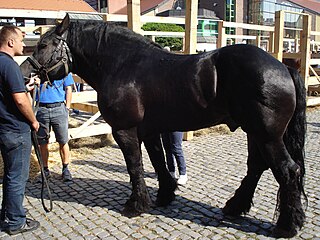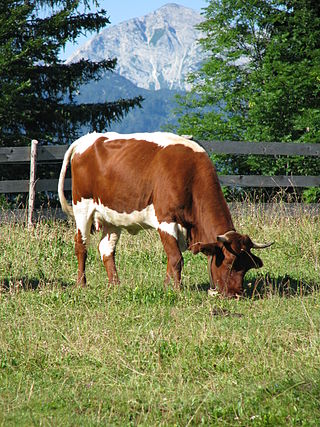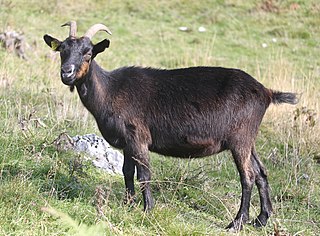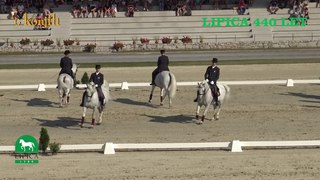
Horse breeding is reproduction in horses, and particularly the human-directed process of selective breeding of animals, particularly purebred horses of a given breed. Planned matings can be used to produce specifically desired characteristics in domesticated horses. Furthermore, modern breeding management and technologies can increase the rate of conception, a healthy pregnancy, and successful foaling.

The Lipizzan or Lipizzaner is a European breed of riding horse developed in the Habsburg Empire in the sixteenth century. It is of Baroque type, and is powerful, slow to mature and long-lived; the coat is usually gray.

The Lusitano, also known as the Pure Blood Lusitano or PSL, is a Portuguese horse breed. Horses were known to be present on the Iberian Peninsula as far back as 20,000 BC, and by 800 BC the region was renowned for its war horses. The fame of the horses from Lusitania goes back to the Roman Age, which attributed its speed to the influence of the West wind, who was considered capable of fertilizing the mares. When the Muslims invaded Iberia in 711 AD, they brought Arabian horses with them that were crossed with the native horses, developing a horse that became useful for war, dressage and bull fighting. The Portuguese horse was named the Lusitano, after the word Lusitania, the ancient Roman name for the region that modern Portugal occupies. There are four main breed lineages within the breed today, and characteristics differ slightly between each line.
The Colorado Ranger is a horse breed from the Colorado High Plains in the United States. The breed is descended from two stallions imported from Turkey to the US state of Virginia in the late 1800s. These stallions were then bred to ranch horses in Nebraska and Colorado, and in the early 1900s the two stallions who every registered Colorado Ranger traces to, Patches #1 and Max #2, were foaled. The breed was championed by rancher Mike Ruby, who founded the Colorado Ranger Horse Association in 1935. Original registry membership limits resulted in many Colorado Ranger horses being registered instead as Appaloosas, but pedigree research is ongoing to discover additional horses who trace their ancestry back to the original stallions.

The Posavac or Posavina, also known as the Croatian Posavac and the Croatian Posavina, is a breed of medium-sized draught horse with a high capacity for weight pulling. Throughout its history, the breed has been popular for pulling wagons. It is also used for forestry, agricultural and other work.

The Međimurje horse is an autochthonous medium-heavy horse breed of draught horse originating from Međimurje County in northernmost part of Croatia.

The Croatian Coldblood is an autochthonous medium-heavy horse breed of draught horse originating from Croatia.

Cika cattle is an autochthonous breed of cattle, originating in Slovenia. This red to chestnut brown cow is used to grazing on alpine pastures and was traditionally raised to serve as a dairy cow – giving people milk and taking care of calves. The Slovenian Cika is the only Slovenian autochthonous breed of cattle.

Altsteirer, also known as the Styrian Hen and Chicken, Slovene: Štajerska kokoš or Štajerka, German: Altsteirer Huhn, is an autochthonous breed of domestic chicken originating in Slovenia and Austrian state Styria. The Styrian Hen is known as the only autochthonous (native) chicken breed of Slovenian area, with all other breeds being traditional at most, hence introduced in the past and consequently adapted to country's conditions. The Altsteirer's set of traits suggests the breed may share a common descent with other Mediterranean chicken breeds.

Drežnica goat is an autochthonous breed of goat, originating in Slovenia, Posočje. Currently it is the only goat breed being listed among Slovenian either autochthonous either traditional breeds of domestic animals. Animals of this breed are middle-sized darker goats, that are being used both for production of milk and dairy products as well as obtaining goat meat.
Slovenian Barred Hen is a traditional breed of domestic chicken, originating in Slovenia. This breed was developed on the Biotechnical Faculty of University of Ljubljana some decades ago. Animals of the Slovenian Barred Hen are barred black and white layer hens, used primarily for production of commercial crossbreeds sold under the trademark Prelux.
Slovenian Brown Hen is a traditional breed of domestic chicken, originating in Slovenia. It was developed at the end of the 20th century at the Biotechnical Faculty of University of Ljubljana. Animals of this breed are brown coloured layer hens that are also used as parents for commercial crossbreeds sold under the trademark Prelux.
Slovenian Silver Hen is a traditional breed of domestic chicken, originating in Slovenia. The breed, that was developed some centuries ago on the Biotechnical Faculty of University of Ljubljana, is characterised by typical white coloured layer hens, used primarily for production of commercial crossbreeds sold under the trademark Prelux.
Prelux are commercial chicken crossbreeds of the Slovenian origin, that are being sold under the eponymous trademark by the Biotechnical Faculty of University of Ljubljana. The name is an abbreviation for the Slovenian phrase prevojski luxuriranci, with a word luxuriranci referring to luxuriance (heterosis) or outbreeding enhancement of hybrid offspring, and adjective prevojski referring to the Slovenian settlement Prevoje, where selective breeding was once performed. This name was given to quality layer hens, that are being obtained by crossbreeding three Slovenian traditional breeds of layer hens; Slovenian Barred, Slovenian Brown and Slovenian Silver Hen. The most known and best-selling layer hens of the trademark Prelux are Prelux-Č, Prelux-G and Prelux-R. A part of the selection is also a meat type chicken (broiler), Prelux-BRO.
Slovene Late-feathered Hen is a traditional breed of domestic chicken, originating in Slovenia. The breed is categorised as a heavy or meat type, and is consequently used for raising broilers. As of year 2013, when two heavy breeds Slovene Early-feathered Hen and Slovenian Fathering Hen were removed from the list, it is the only meat type chicken breed among Slovenian traditional breeds of domestic animals. The Slovene Late-feathered Hen is characterised by animals covered with white plumage and known for slow feathering speed.

Krškopolje pig or Black-belted pig is an autochthonous breed of pig, originating in Slovenia. This pig represents the only still preserved Slovenian autochthonous breed of domestic pig. The easily recognizable blackish Krškopolje pig, widely used for meat production, is well known for its continuous pink belt, running across animal's shoulders and forelimbs.

The Ljutomer Trotter is a traditional breed of horse, originating in Slovenia in the town Ljutomer, where it was developed around year 1880. It is a breed of typical medium-sized warmbloods, with a majority of animals being bay. Until around 1960 animals were used for various farm tasks and transport, while today the breed is being reared and used primarily for sport purposes and recreational riding.

Horses in Slovenia are represented above all by the traditional Lipizzan breed, inherited from Austria-Hungary; like Austria, Slovenia claims the Lipizzan as its national symbol. Horses have long been present on Slovenian territory; draft horses suffered a sharp decline in the 20th century, with only the native breeds of Slovenian Cold-blood and Posavina surviving. Slovenian breeders also have sport horses, such as the Slovenian Saddlebred and the Ljutomer Trotter. Slovenians distinguish their native horse breeds from traditional breeds.













